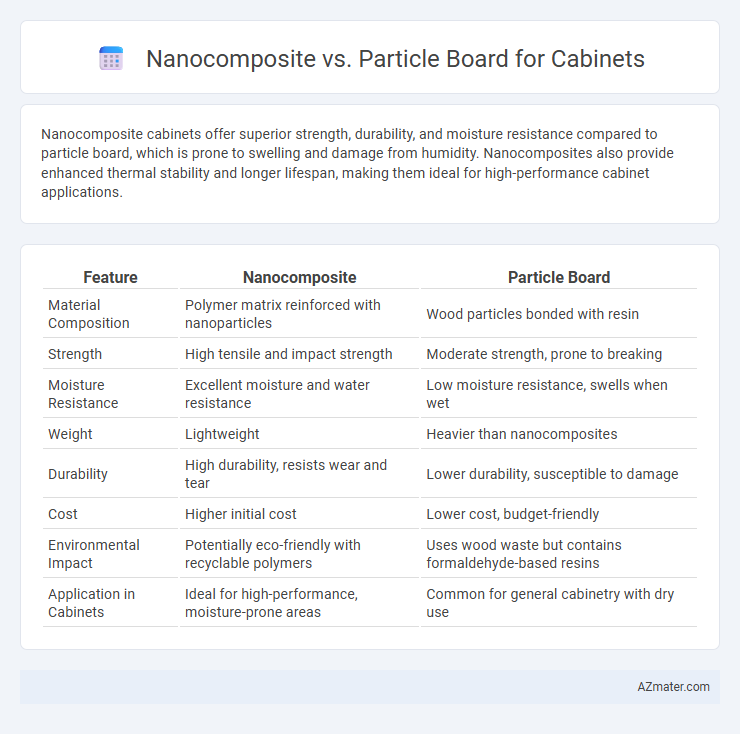Nanocomposite cabinets offer superior strength, durability, and moisture resistance compared to particle board, which is prone to swelling and damage from humidity. Nanocomposites also provide enhanced thermal stability and longer lifespan, making them ideal for high-performance cabinet applications.
Table of Comparison
| Feature | Nanocomposite | Particle Board |
|---|---|---|
| Material Composition | Polymer matrix reinforced with nanoparticles | Wood particles bonded with resin |
| Strength | High tensile and impact strength | Moderate strength, prone to breaking |
| Moisture Resistance | Excellent moisture and water resistance | Low moisture resistance, swells when wet |
| Weight | Lightweight | Heavier than nanocomposites |
| Durability | High durability, resists wear and tear | Lower durability, susceptible to damage |
| Cost | Higher initial cost | Lower cost, budget-friendly |
| Environmental Impact | Potentially eco-friendly with recyclable polymers | Uses wood waste but contains formaldehyde-based resins |
| Application in Cabinets | Ideal for high-performance, moisture-prone areas | Common for general cabinetry with dry use |
Introduction to Cabinet Material Choices
Nanocomposites offer enhanced strength, durability, and moisture resistance compared to traditional particle board, making them an innovative choice for cabinet construction. Particle board, composed of wood chips and resin, remains popular for its affordability and ease of finishing but often lacks the longevity and structural integrity of nanocomposites. Selecting between nanocomposite and particle board hinges on factors like budget, desired lifespan, and environmental exposure in cabinet applications.
Understanding Nanocomposite Materials
Nanocomposite materials used in cabinets combine nanoparticles with traditional composites to significantly enhance mechanical strength, durability, and resistance to moisture compared to particle board. These nanomaterials improve cabinet performance by offering superior structural integrity and surface smoothness, which minimizes warping and swelling commonly seen in particle boards. Understanding the molecular-level interactions within nanocomposite structures reveals their advantages in long-term stability and aesthetic appeal for cabinetry applications.
What is Particle Board?
Particle board is an engineered wood product made from wood chips, sawmill shavings, or wood dust bonded together with a synthetic resin or other binder under heat and pressure. It is widely used in cabinetry due to its cost-effectiveness and smooth surface suitable for laminates or veneers. Compared to nanocomposite materials, particle board has lower strength and moisture resistance, which can affect cabinet durability over time.
Strength and Durability Comparison
Nanocomposite cabinets offer superior strength and durability compared to particle board due to their advanced material composition incorporating nanoparticles that enhance mechanical properties and resistance to wear. Particle board, made from wood chips and resin, is prone to swelling and sagging when exposed to moisture, reducing its lifespan in cabinetry applications. Nanocomposites exhibit better impact resistance, higher load-bearing capacity, and longer service life, making them a preferred choice for high-performance cabinet construction.
Moisture Resistance and Longevity
Nanocomposite cabinets offer superior moisture resistance compared to particle board due to their advanced polymer matrix combined with nanoscale fillers, which effectively block water penetration. This enhanced moisture resistance significantly extends the longevity of nanocomposite cabinets in humid or wet environments, preventing warping, swelling, and microbial growth common in particle board. Particle board, made from wood chips and adhesives, tends to absorb moisture, leading to reduced durability and frequent replacement in kitchens and bathrooms.
Weight and Structural Implications
Nanocomposites used in cabinet manufacturing offer superior strength-to-weight ratios compared to traditional particle boards, resulting in lighter yet more durable cabinetry. The incorporation of nanomaterials enhances mechanical properties such as stiffness and impact resistance while reducing overall weight, improving load-bearing capacity without compromising structural integrity. Particle board, composed of compressed wood particles and adhesives, tends to be heavier and less resilient under stress, making nanocomposite options preferable for high-performance, lightweight cabinet designs.
Environmental Impact and Sustainability
Nanocomposite cabinets offer superior environmental benefits over traditional particle boards due to their use of renewable materials and lower emissions during production. Particle boards often rely on formaldehyde-based adhesives, contributing to indoor air pollution and limited recyclability. The nanocomposite's enhanced durability extends cabinet lifespan, reducing waste and promoting sustainability in cabinetry applications.
Cost Analysis: Nanocomposite vs Particle Board
Nanocomposite cabinets generally incur higher initial costs compared to particle board due to advanced materials and manufacturing technologies involved. However, nanocomposites offer superior durability and resistance to moisture and wear, potentially lowering long-term maintenance and replacement expenses. Particle board remains a budget-friendly option but may incur increased costs over time due to susceptibility to damage and shorter lifespan.
Aesthetic Versatility and Design Options
Nanocomposites offer superior aesthetic versatility for cabinets by enabling smooth finishes and customizable textures that mimic natural materials like wood or stone. Particle boards have limited design options due to their uniform composition and susceptibility to surface damage, often requiring laminates or veneers for visual appeal. Nanocomposite technology enhances durability and color retention, providing a broader palette and creative freedom for modern cabinet designs.
Which Material is Best for Your Cabinets?
Nanocomposite materials offer superior strength, moisture resistance, and durability compared to traditional particle board, making them ideal for high-use kitchen cabinets. Particle board is more affordable and easier to work with but tends to absorb moisture and deteriorate over time, especially in humid environments. Choosing nanocomposite ensures longer-lasting cabinets with better structural integrity, while particle board suits budget-conscious projects with less exposure to water.

Infographic: Nanocomposite vs Particle board for Cabinet
 azmater.com
azmater.com